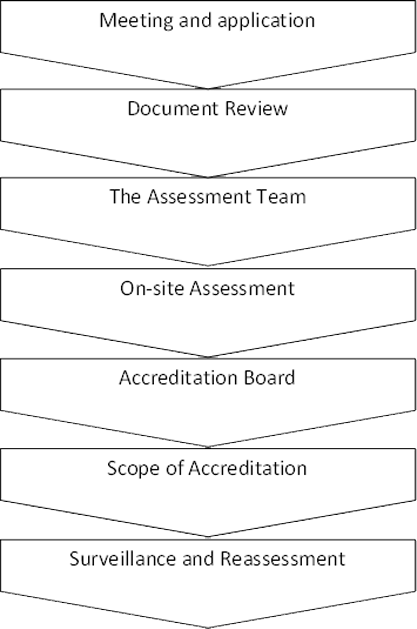What is Accreditation?
Accreditation is a process in which certification of competency, authority, or credibility is presented.
Organizations that issue credentials or certify third parties against official standards are themselves formally accredited by accreditation bodies ; hence they are sometimes known as “accredited certification bodies”. The accreditation process ensures that their certification practices are acceptable, typically meaning that they are competent to test and certify third parties, behave ethically, and employ suitable quality assurance.
Benefits of Accreditation
For businesses
Accurate calibration, measurement and testing, performed in accordance with best practice, help limit errors and product failure, improve control of production costs and contribute to an innovative environment.
Accreditation is an independent demonstration of your technical competence to customers.
after they obtain certification of their control services by way of an accredited body, agencies constantly improve their overall performance by using the use of a recognized tool for decision-making, risk management and dealer choice. for this reason, they experience a competitive advantage in phrases of recognition and credibility, each at the b2b and customer markets and also have an additional marketing tool.
Reducing controls
Accredited certification conveys presumption of conformity with official standards and regulations. This means that businesses do not need to provide additional evidence, and their activities are simplified subsequent to reduction or elimination of controls.
Supporting export
The international recognition of conformity assessment reports covered by accreditation boosts business expansion on foreign markets without the need to carry out additional verifications.
For regulators
Testing, examination, verification, inspection, calibration and certification can be used for better control and regulation.
The services provided by accredited bodies, either used directly by regulators and governments or as a tool reference in rules and regulations, demonstrate effectiveness in:
- supporting implementation of the International or national legislation, providing a “stamp of approval” to confirm compliance with standards and widely accepted requirements qualifying suppliers of goods and services, especially on the procurement market enhancing trade and economic growth, providing governments with reliable data reducing bureaucracy by eliminating a number of administrative obligations limiting costs and resources, by reducing the need for regulators to employ their specialized assessment personnel and by avoiding duplication of audits simplifying the procurement process by ensuring confidence as a decision-making tool
For consumers
Creating trust
Increasingly consumers rely on independent evidence, rather than simply believing in suppliers’ advertisements. Consumers’ confidence on the market is enhanced when they know that the products and services they choose are regularly evaluated and checked by an independent and competent third party. Choosing a product based on its certification mark, consumers can be sure of the quality of what they are buying.
Protecting, in the public interest
At the other end of the supply chain, consumers’ interest is protected by national accreditation bodies acting as “checkers”.
Accreditation Process

This section provides a step-by-step guide through the key steps of the accreditation process.
Meeting & Application
Application forms, regulations, policies and technical guides can be downloaded from this website. It is recommended to hold a meeting prior to the submission of the application form .
Document Review
The documents submitted by the applicant are assessed by the Lead Assessor and, where necessary, by the Technical Assessors. This desk audit helps to identify whether there is the need for further documentation, the need for a preliminary visit, to highlight any deficiencies in the system and to propose the final composition of the Assessment Team.
Assessment Team
The Assessment Team is selected according to the scope of accreditation as well as on the basis of the outcome of any preliminary visit. Collectively the team will have the competence to cover every aspect of the organisation’s operations.
All assessors pass a rigorous selection exercise and any external assessors sign a confidentiality agreement since it is vital that any information gained during any assessment activity is kept confidential.
On-site assessment
The result of the on-site and witness visit is a detailed report on the evaluation of the organisation highlighting any areas that require attention prior to the organisation being recommended for accreditation.
Accreditation Board
The Board is responsible for taking the decision on the granting/withdrawal of accreditation. This is based on a report based on the outcome of the on-site assessment.
Scope of Accreditation
The accreditation certificate is issued against a scope of accreditation which details the specific areas accredited. The scope is published and maintained by the Accr. Organization.
Surveillance & Reassessment
Surveillance activities, including on-site visits, are carried out to ensure that the accredited conformity assessment body continues to conform to the requirements of accreditation on a permanent basis. The first surveillance visit is normally carried out 6 months after the decision on accreditation. The accredited conformity assessment body will have to undergo a full reassessment equivalent in detail to the original assessment after a five year period.
